coolant TOYOTA HIGHLANDER 2013 XU50 / 3.G User Guide
[x] Cancel search | Manufacturer: TOYOTA, Model Year: 2013, Model line: HIGHLANDER, Model: TOYOTA HIGHLANDER 2013 XU50 / 3.GPages: 684, PDF Size: 15.42 MB
Page 514 of 684
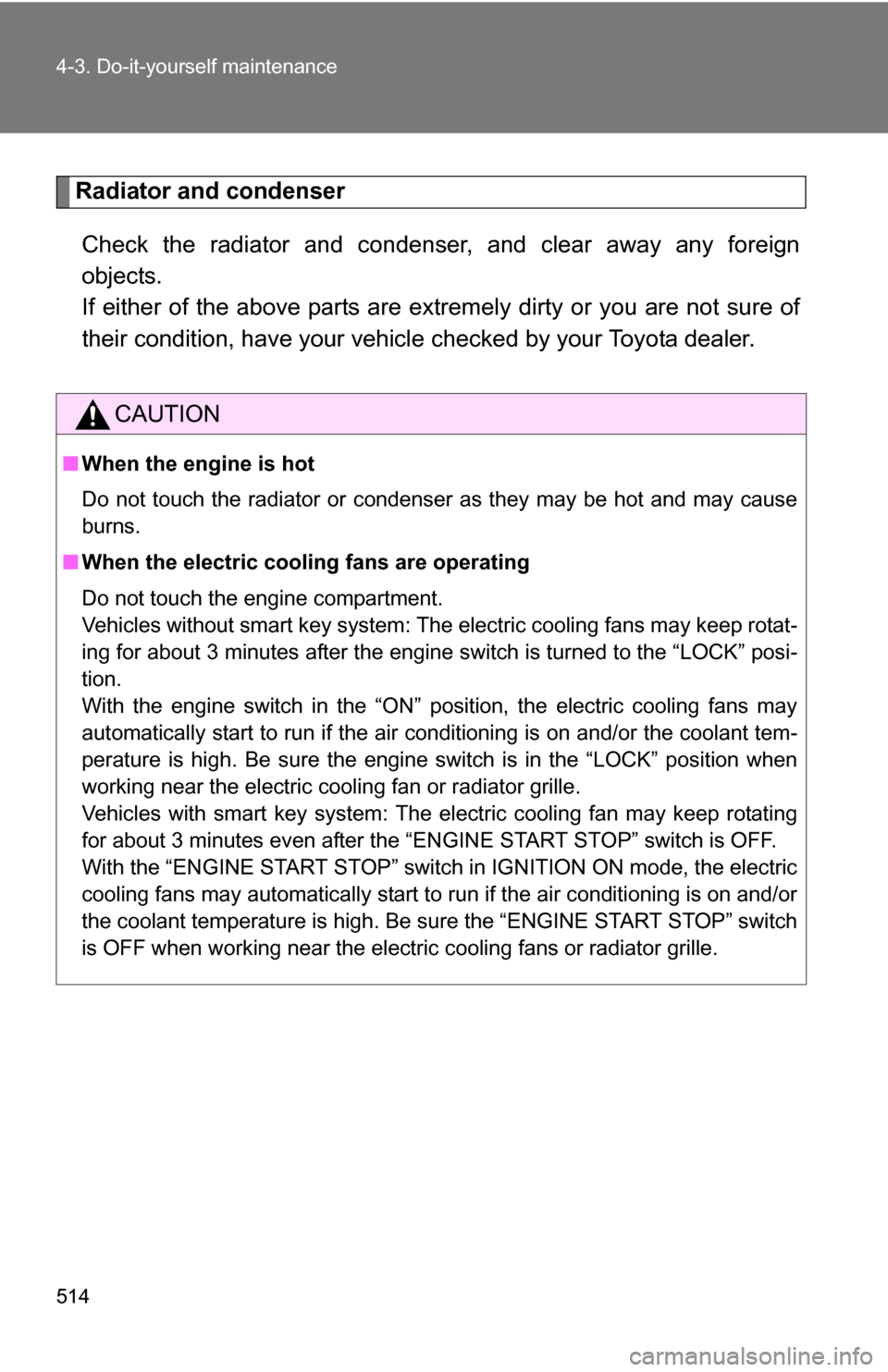
514 4-3. Do-it-yourself maintenance
Radiator and condenserCheck the radiator and condenser, and clear away any foreign
objects.
If either of the above parts are ex tremely dirty or you are not sure of
their condition, have your vehicl e checked by your Toyota dealer.
CAUTION
■When the engine is hot
Do not touch the radiator or condenser as they may be hot and may cause
burns.
■ When the electric cooling fans are operating
Do not touch the engine compartment.
Vehicles without smart key system: The electric cooling fans may keep rotat-
ing for about 3 minutes after the engine switch is turned to the “LOCK” posi-
tion.
With the engine switch in the “ON” position, the electric cooling fans may
automatically start to run if the air conditioning is on and/or the coolant tem-
perature is high. Be sure the engine switch is in the “LOCK” position when
working near the electric cooling fan or radiator grille.
Vehicles with smart key system: The electric cooling fan may keep rotating
for about 3 minutes even after the “ENGINE START STOP” switch is OFF.
With the “ENGINE START STOP” switch in IGNITION ON mode, the electric
cooling fans may automatically start to run if the air conditioning is on and/or
the coolant temperature is high. Be sure the “ENGINE START STOP” switch
is OFF when working near the electric cooling fans or radiator grille.
Page 571 of 684
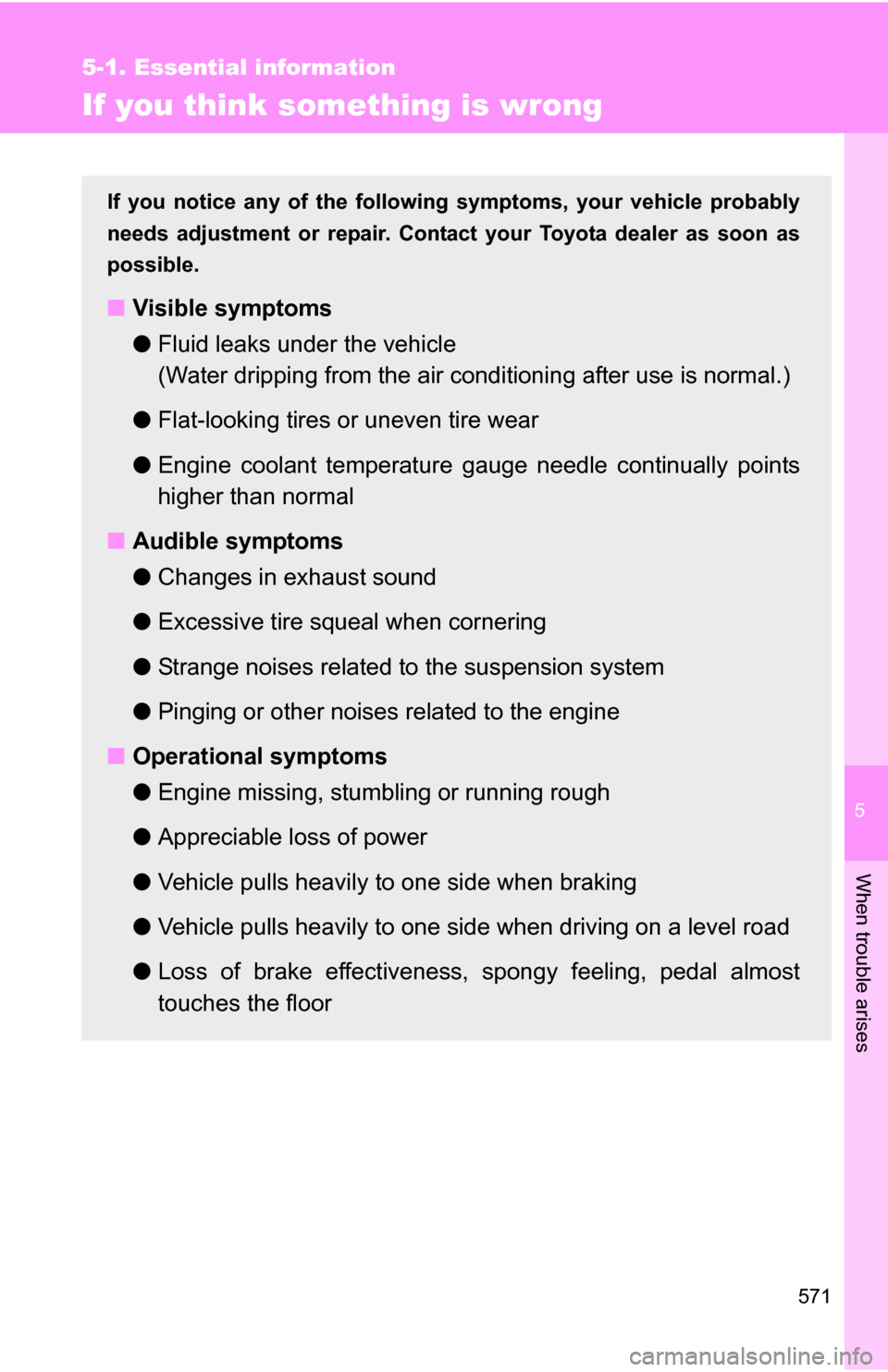
5
When trouble arises
571
5-1. Essential information
If you think something is wrong
If you notice any of the following symptoms, your vehicle probably
needs adjustment or repair. Contact your Toyota dealer as soon as
possible.
■ Visible symptoms
●Fluid leaks under the vehicle
(Water dripping from the air cond itioning after use is normal.)
● Flat-looking tires or uneven tire wear
● Engine coolant temperature g auge needle continually points
higher than normal
■ Audible symptoms
●Changes in exhaust sound
● Excessive tire squeal when cornering
● Strange noises related to the suspension system
● Pinging or other noises related to the engine
■ Operational symptoms
●Engine missing, stumbling or running rough
● Appreciable loss of power
● Vehicle pulls heavily to one side when braking
● Vehicle pulls heavily to one side when driving on a level road
● Loss of brake effectiveness, s pongy feeling, pedal almost
touches the floor
Page 610 of 684
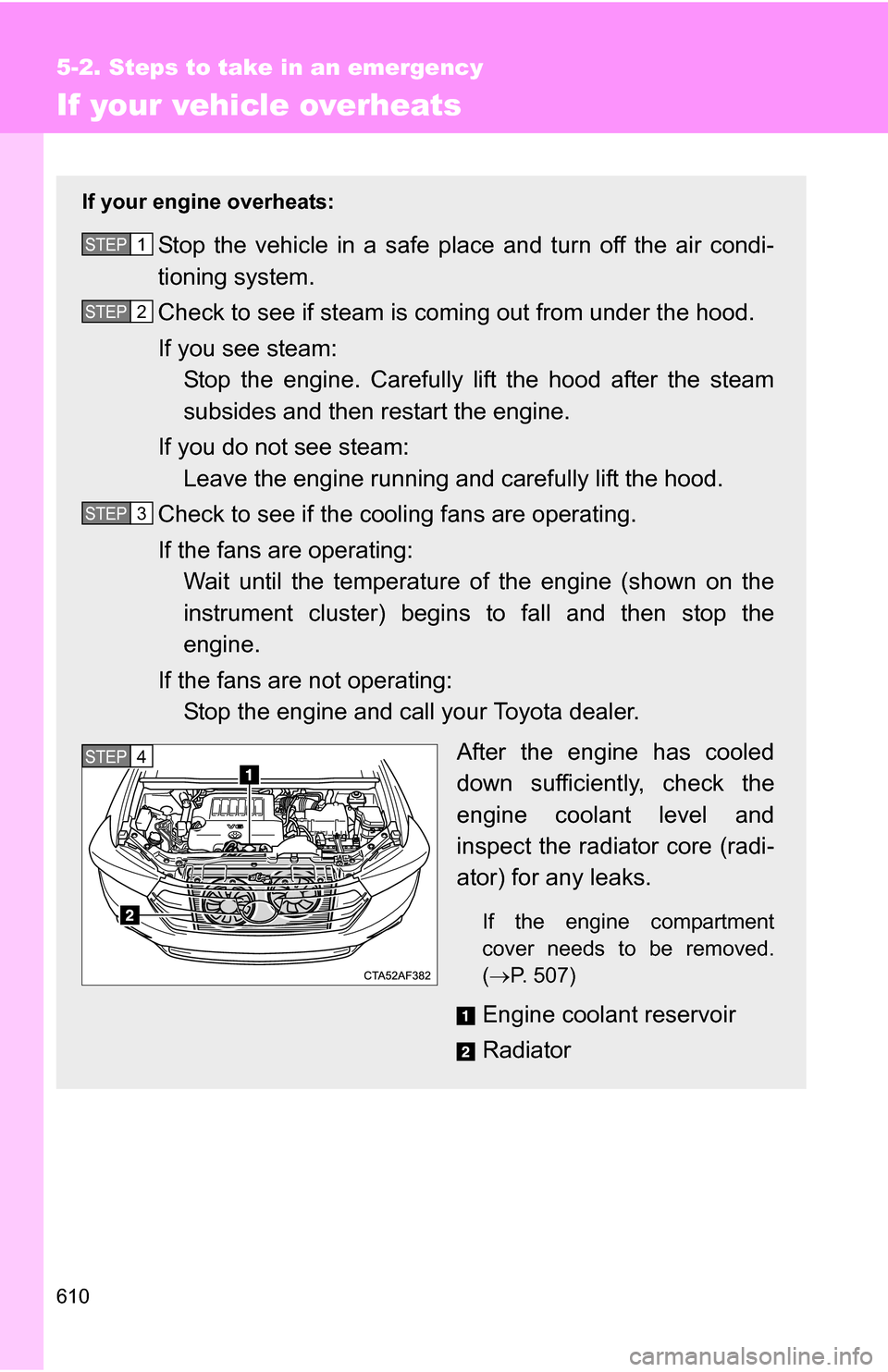
610
5-2. Steps to take in an emergency
If your vehicle overheats
If your engine overheats:
Stop the vehicle in a safe place and turn off the air condi-
tioning system.
Check to see if steam is coming out from under the hood.
If you see steam: Stop the engine. Carefully lift the hood after the steam
subsides and then restart the engine.
If you do not see steam: Leave the engine running and carefully lift the hood.
Check to see if the cooling fans are operating.
If the fans are operating: Wait until the temperature of the engine (shown on the
instrument cluster) begins to fall and then stop the
engine.
If the fans are not operating: Stop the engine and call your Toyota dealer.
After the engine has cooled
down sufficiently, check the
engine coolant level and
inspect the radiator core (radi-
ator) for any leaks.
If the engine compartment
cover needs to be removed.
(P. 507)
Engine coolant reservoir
Radiator
STEP1
STEP2
STEP3
STEP4
Page 611 of 684
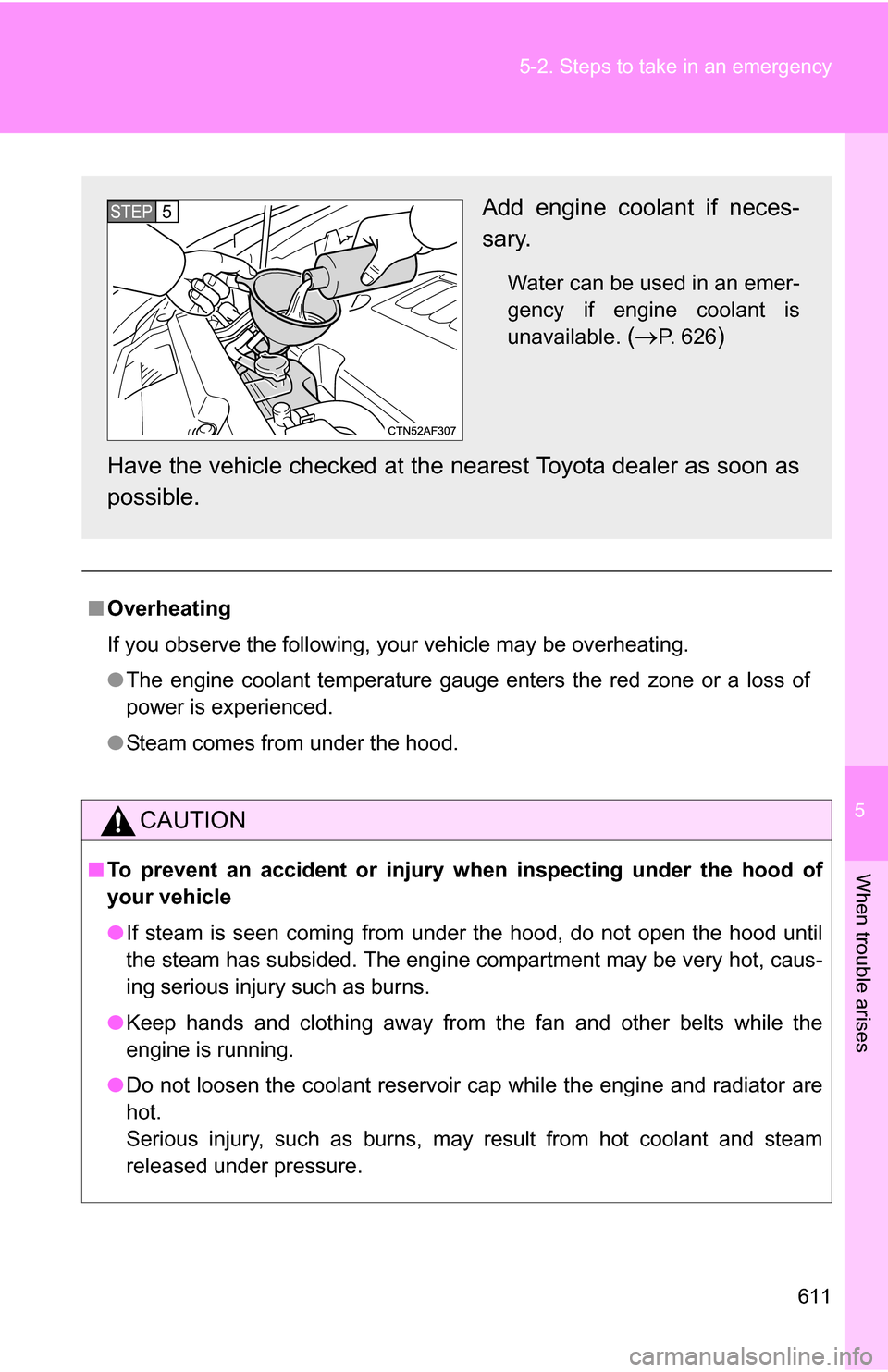
5
When trouble arises
611
5-2. Steps to take in an emergency
■
Overheating
If you observe the following, your vehicle may be overheating.
●The engine coolant temperature gauge enters the red zone or a loss of
power is experienced.
● Steam comes from under the hood.
CAUTION
■To prevent an accident or injury when inspecting under the hood of
your vehicle
●If steam is seen coming from under the hood, do not open the hood until
the steam has subsided. The engine compartment may be very hot, caus-
ing serious injury such as burns.
● Keep hands and clothing away from the fan and other belts while the
engine is running.
● Do not loosen the coolant reservoir cap while the engine and radiator are
hot.
Serious injury, such as burns, may result from hot coolant and steam
released under pressure.
Add engine coolant if neces-
sary.
Water can be used in an emer-
gency if engine coolant is
unavailable.
(P. 626)
Have the vehicle chec ked at the nearest Toyota dealer as soon as
possible.
STEP5
Page 612 of 684
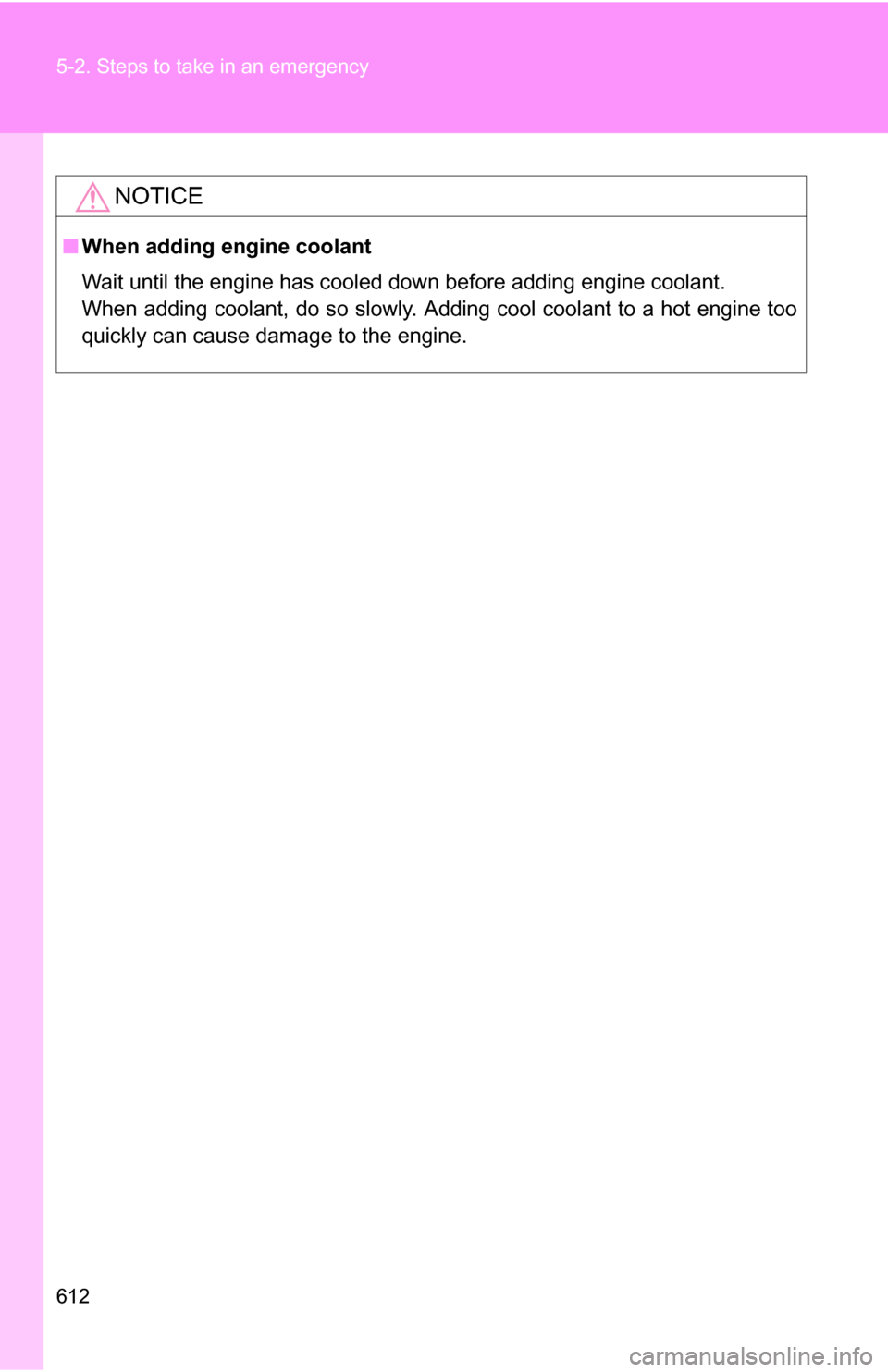
612 5-2. Steps to take in an emergency
NOTICE
■When adding engine coolant
Wait until the engine has cooled down before adding engine coolant.
When adding coolant, do so slowly. Adding cool coolant to a hot engine too
quickly can cause damage to the engine.
Page 626 of 684
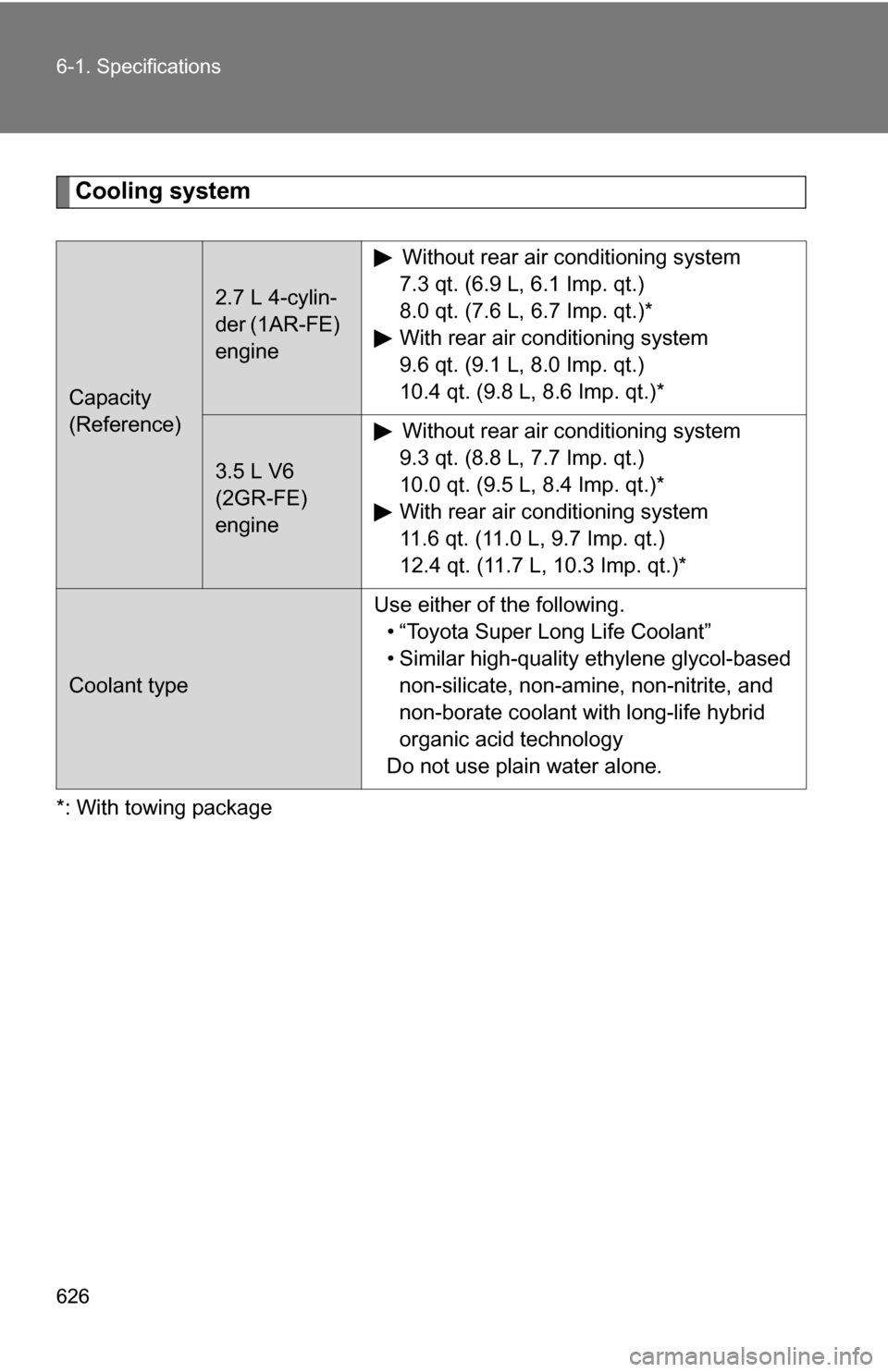
626 6-1. Specifications
Cooling system
*: With towing package
Capacity
(Reference)
2.7 L 4-cylin-
der (1AR-FE)
engineWithout rear air conditioning system
7.3 qt. (6.9 L, 6.1 Imp. qt.)
8.0 qt. (7.6 L, 6.7 Imp. qt.)*
With rear air conditioning system
9.6 qt. (9.1 L, 8.0 Imp. qt.)
10.4 qt. (9.8 L, 8.6 Imp. qt.)*
3.5 L V6
(2GR-FE)
engine Without rear air conditioning system
9.3 qt. (8.8 L, 7.7 Imp. qt.)
10.0 qt. (9.5 L, 8.4 Imp. qt.)*
With rear air conditioning system
11.6 qt. (11.0 L, 9.7 Imp. qt.)
12.4 qt. (11.7 L, 10.3 Imp. qt.)*
Coolant type Use either of the following.
• “Toyota Super Long Life Coolant”
• Similar high-quality ethylene glycol-based non-silicate, non-amine, non-nitrite, and
non-borate coolant with long-life hybrid
organic acid technology
Do not use plain water alone.
Page 642 of 684
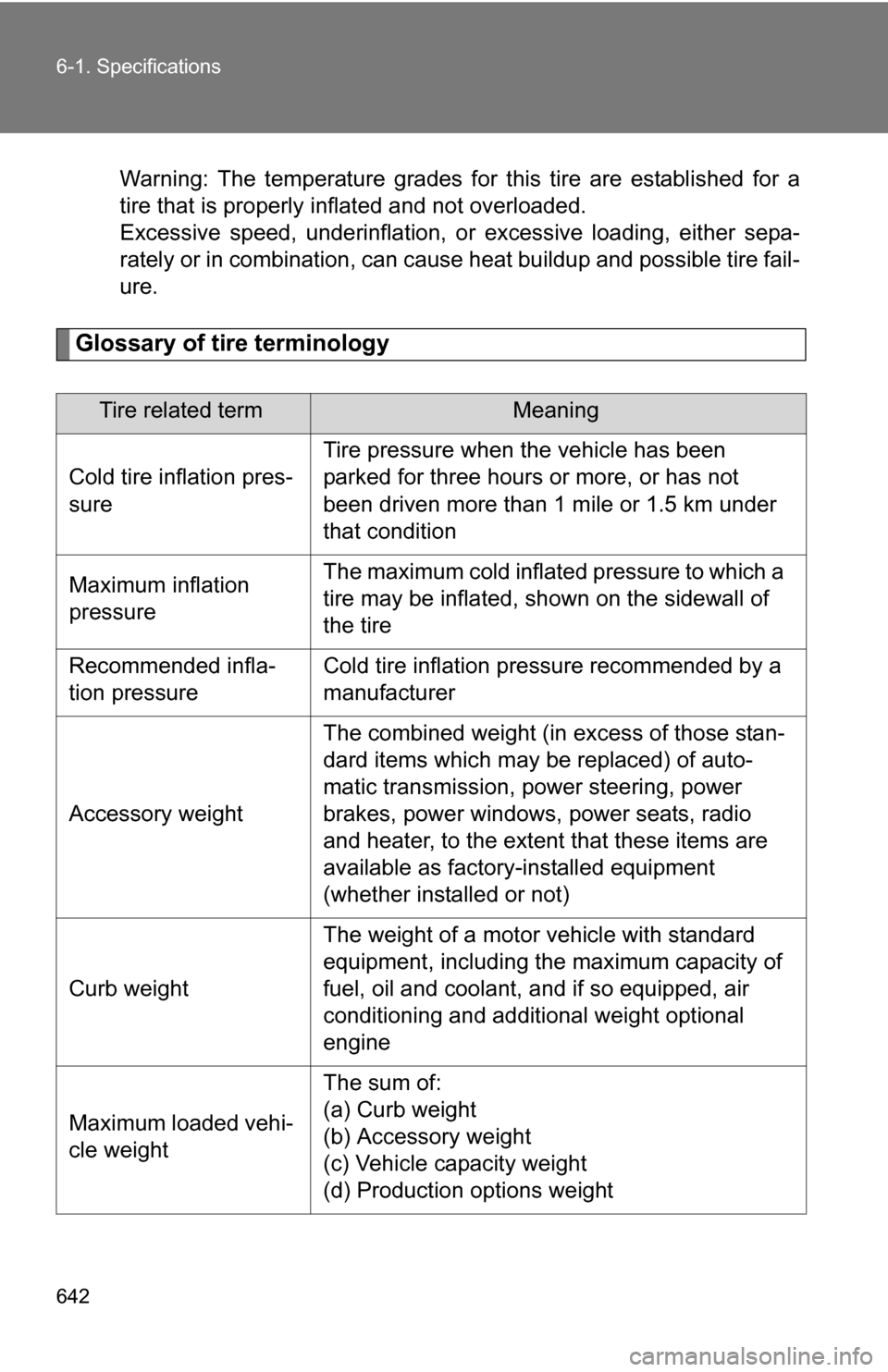
642 6-1. Specifications
Warning: The temperature grades for this tire are established for a
tire that is properly inflated and not overloaded.
Excessive speed, underinflation, or excessive loading, either sepa-
rately or in combination, can cause heat buildup and possible tire fail-
ure.
Glossary of tire terminology
Tire related termMeaning
Cold tire inflation pres-
sure Tire pressure when the vehicle has been
parked for three hours or more, or has not
been driven more than 1 mile or 1.5 km under
that condition
Maximum inflation
pressure The maximum cold inflated
pressure to which a
tire may be inflated, s hown on the sidewall of
the tire
Recommended infla-
tion pressure Cold tire inflation pressure recommended by a
manufacturer
Accessory weight The combined weight (in excess of those stan-
dard items which may be replaced) of auto-
matic transmission, power steering, power
brakes, power windows, power seats, radio
and heater, to the extent that these items are
available as factory-installed equipment
(whether installed or not)
Curb weight The weight of a motor vehicle with standard
equipment, including the maximum capacity of
fuel, oil and coolant, and if so equipped, air
conditioning and additional weight optional
engine
Maximum loaded vehi-
cle weight The sum of:
(a) Curb weight
(b) Accessory weight
(c) Vehicle capacity weight
(d) Production options weight
Page 673 of 684
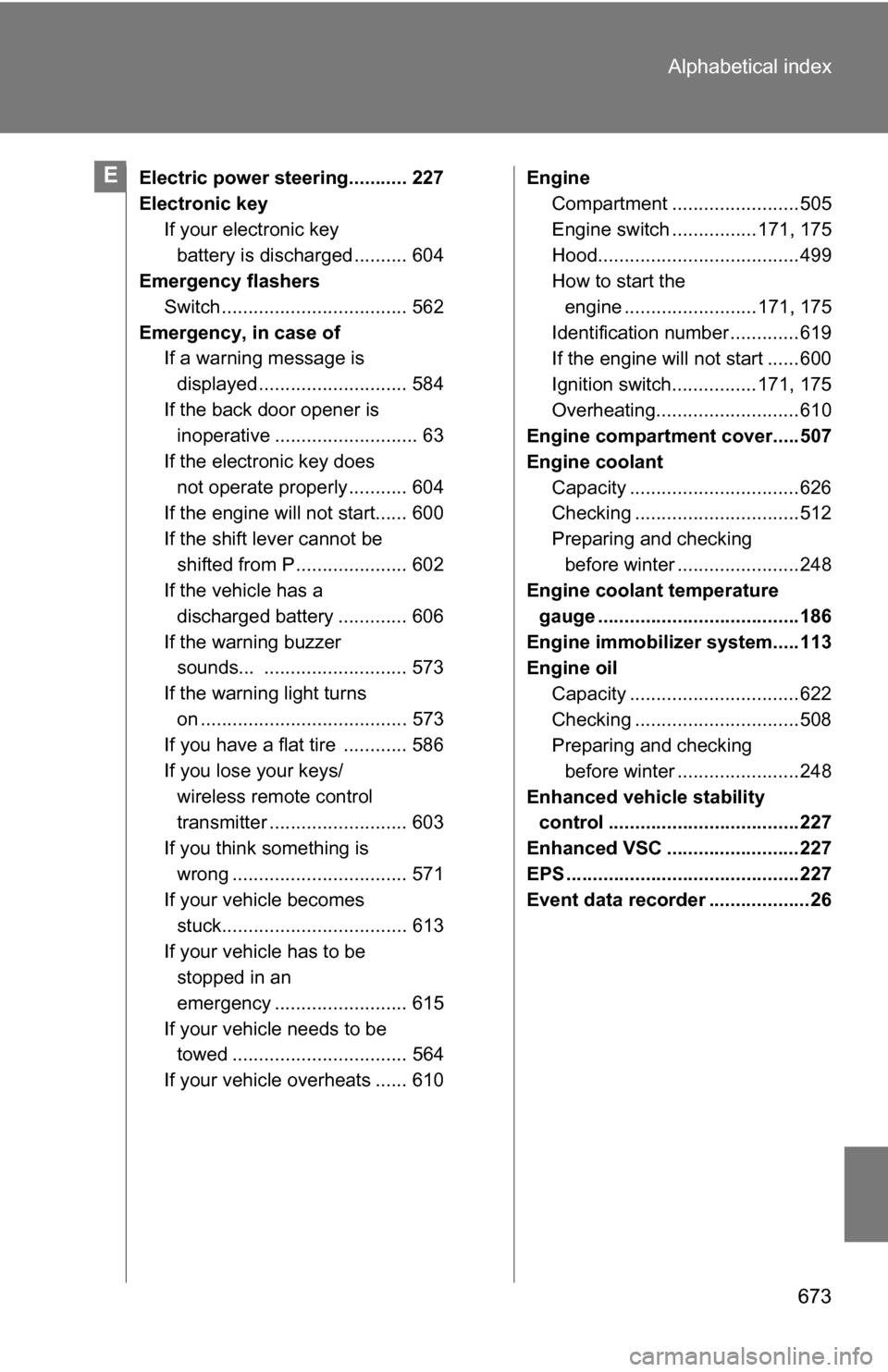
673
Alphabetical index
Electric power steering........... 227
Electronic key
If your electronic key battery is discharged .......... 604
Emergency flashers
Switch ................................... 562
Emergency, in case of If a warning message is
displayed ............................ 584
If the back door opener is inoperative ........................... 63
If the electronic key does not operate properly ........... 604
If the engine will not start...... 600
If the shift lever cannot be
shifted from P ..................... 602
If the vehicle has a
discharged battery ............. 606
If the warning buzzer sounds... ........................... 573
If the warning light turns on ....................................... 573
If you have a flat tire ............ 586
If you lose your keys/
wireless remote control
transmitter .......................... 603
If you think something is wrong ................................. 571
If your vehicle becomes
stuck................................... 613
If your vehicle has to be stopped in an
emergency ......................... 615
If your vehicle needs to be towed ................................. 564
If your vehicle overheats ...... 610 Engine
Compartment ........................505
Engine switch ................171, 175
Hood......................................499
How to start the
engine .........................171, 175
Identification number .............619
If the engine will not start ......600
Ignition switch................171, 175
Overheating...........................610
Engine compartment cover.....507
Engine coolant
Capacity ................................626
Checking ...............................512
Preparing and checking before winter .......................248
Engine coolan t temperature
gauge ......................................186
Engine immobilizer system.....113
Engine oil Capacity ................................622
Checking ...............................508
Preparing and checking before winter .......................248
Enhanced vehicle stability control ....................................227
Enhanced VSC .........................227
EPS ............................................227
Event data recorder ...................26E
Page 681 of 684
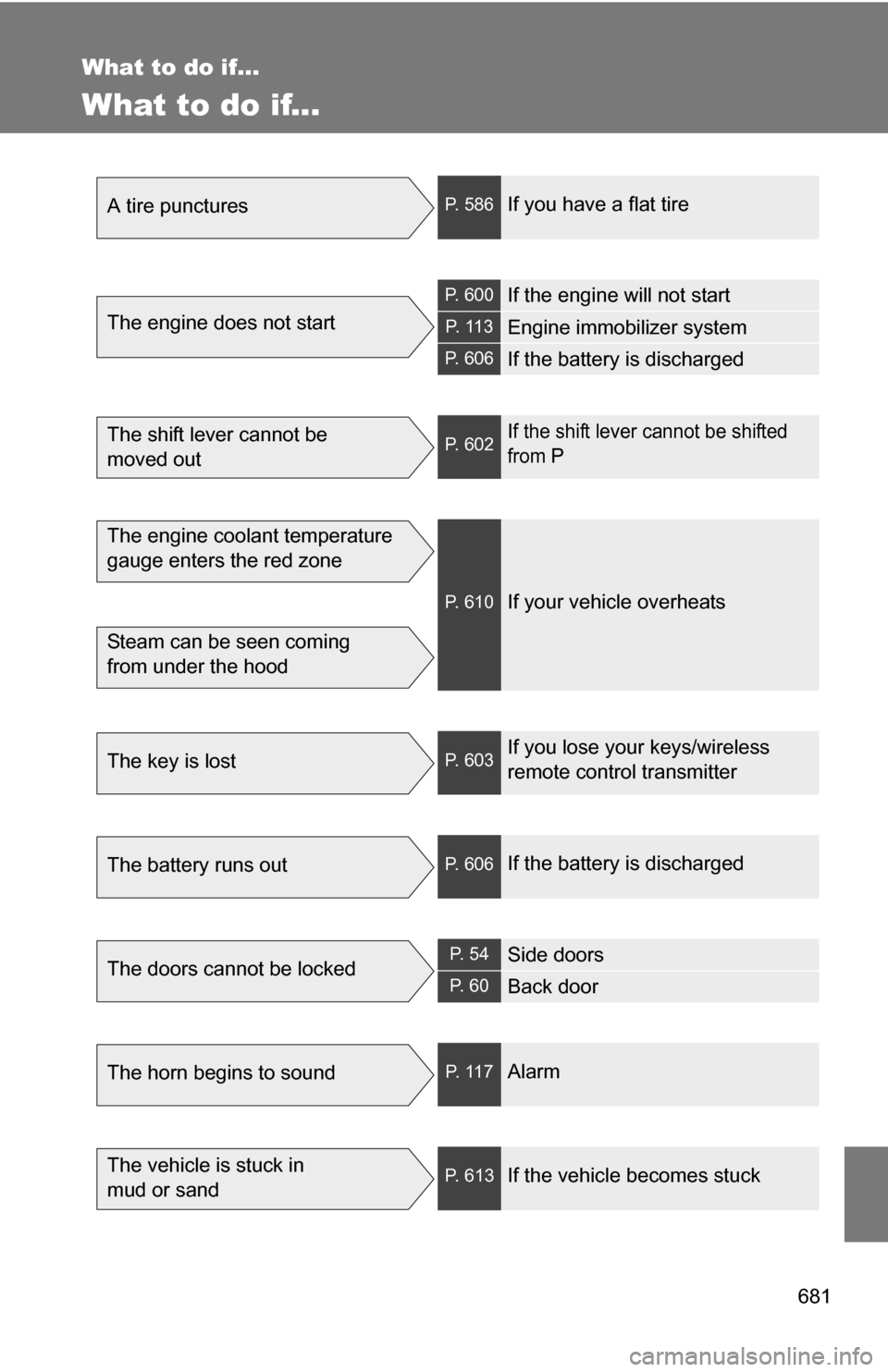
681
What to do if...
What to do if...
A tire puncturesP. 586If you have a flat tire
The engine does not start
P. 600If the engine will not start
P. 1 1 3Engine immobilizer system
P. 606If the battery is discharged
The shift lever cannot be
moved outP. 602If the shift lever cannot be shifted
from P
The engine coolant temperature
gauge enters the red zone
Steam can be seen coming
from under the hood
P. 610If your vehicle overheats
The key is lostP. 603If you lose your keys/wireless
remote control transmitter
The battery runs outP. 606If the battery is discharged
The doors cannot be lockedP. 5 4Side doors
P. 6 0Back door
The horn begins to soundP. 1 1 7Alarm
The vehicle is stuck in
mud or sandP. 613If the vehicle becomes stuck